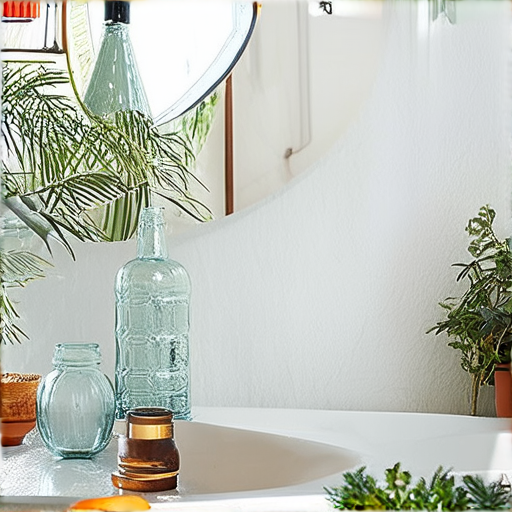Transform your bathroom into a haven of sustainability by embracing the principles of a zero waste bathroom. This eco-friendly approach not only reduces your environmental footprint but also promotes a healthier living space. With the average person using around 50 pounds of toilet paper per year, it’s clear that making small changes can add up to make a significant impact. By adopting simple habits and switching to sustainable bathroom materials, you can significantly reduce your waste output and contribute to a greener home.

Creating a Zero Waste Bathroom
We’re committed to helping you live a more sustainable lifestyle, which is why we’ve put together these simple steps to create a zero-waste bathroom.
-
Switch to Reusable Products
One of the easiest ways to reduce waste in your bathroom is to switch to reusable products. Consider replacing disposable razors with a safety razor, and opt for bamboo toothbrushes instead of plastic ones.
- Bamboo toothbrushes are biodegradable and compostable, reducing the amount of plastic waste in our oceans.
- Safety razors are a cost-effective alternative to disposable razors and can be refilled with replacement blades.
-
Choose Eco-Friendly Cleaning Products
Making the switch to eco-friendly cleaning products is a great way to reduce your carbon footprint and create a healthier environment in your home.
- Look for cleaning products that are free from harsh chemicals and artificial fragrances.
- Consider making your own cleaning solutions using natural ingredients like baking soda and vinegar.
-
Reduce Paper Waste
Paper towels and toilet paper rolls can quickly add up and contribute to deforestation and waste.
- Switch to reusable cloths or rags for cleaning and drying tasks.
- Opt for bamboo or recycled paper products whenever possible.
-
Implement a Recycling Program
A recycling program can help divert waste from landfills and reduce the need for new raw materials.
- Set up a recycling bin in your bathroom for collecting recyclable materials like plastic bottles and cardboard tubes.
- Participate in local recycling programs or community composting initiatives.
-
Minimize Packaging Waste
Reducing packaging waste is a crucial step in creating a zero-waste bathroom.
- Buy products in bulk or choose items with minimal packaging.
- Avoid products with excessive packaging or those that use non-biodegradable materials.
By implementing these simple changes, you’ll be well on your way to creating a zero-waste bathroom that’s better for the planet and your wallet.
How to Clean a Toilet with Zero Waste
We’re committed to helping you live a more sustainable life, which is why we’ve put together these steps on how to clean a toilet with zero waste.
-
Step 1: Gather Your Supplies
- Baking soda
- White vinegar
- Castile soap
- Microfiber cloth
- Water
-
Step 2: Remove Visible Debris
-
Step 3: Create a Natural Cleaning Solution
-
Step 4: Apply the Cleaning Solution
-
Step 5: Scrub the Toilet Bowl
-
Step 6: Rinse the Toilet Bowl
-
Step 7: Disinfect the Toilet Seat and Handle
-
Step 8: Dry the Toilet Bowl
Start by removing any visible debris from the toilet bowl using a microfiber cloth or a small brush.
Mix 1 cup of baking soda with 1 cup of white vinegar to create a natural cleaning solution.
Apply the cleaning solution to the toilet bowl and let it sit for 10-15 minutes.
Use a microfiber cloth to scrub the toilet bowl and remove any stubborn stains.
Rinse the toilet bowl thoroughly with water to remove any remaining cleaning solution.
Use castile soap and water to disinfect the toilet seat and handle.
Use a microfiber cloth to dry the toilet bowl and prevent water spots.
By following these simple steps, you can keep your toilet clean and hygienic without generating any waste.
At Eco Planeta Verde, we’re passionate about helping you live a more sustainable life. Check out our website for more tips and resources on reducing waste and living eco-friendlily.
For more information on sustainable living, check out our guide on Sustainable Living.
Additionally, you may want to consider using a Zero-Waste Product to reduce your waste output.
Remember, every small change counts, and by making a few simple changes to your daily routine, you can make a big difference in reducing waste and living sustainably.

Is Toilet Paper Zero Waste?
The short answer is no, traditional toilet paper is not zero waste.
-
Toilet paper production involves cutting down trees, which contributes to deforestation and habitat destruction.
-
The manufacturing process requires large amounts of water, energy, and chemicals, resulting in significant greenhouse gas emissions.
-
Transportation and packaging contribute to carbon emissions and waste generation.
Alternatives to Traditional Toilet Paper:
-
Bamboo toilet paper is a more sustainable option, as bamboo is a fast-growing crop that requires less water and pesticides compared to traditional wood pulp.
-
Recycled toilet paper made from post-consumer waste reduces the demand for virgin wood pulp and helps divert waste from landfills.
-
Composting toilets eliminate the need for traditional toilet paper altogether, reducing waste and minimizing environmental impact.
-
Square-shaped toilet paper, also known as “bidets,” reduce the amount of paper needed per use and promote better hygiene.
Zero-Waste Toilet Paper Options:
-
EcoPlanetaVerde recommends exploring alternative toilet paper options, such as those made from bamboo, recycled materials, or compostable fibers.
-
Consider switching to a bidet or installing a composting toilet to minimize waste and reduce environmental impact.
-
Look for certified sustainable and eco-friendly toilet paper products that meet rigorous environmental standards.
Conclusion:
While traditional toilet paper is not zero waste, there are alternatives available that offer a more sustainable solution. By choosing eco-friendly options and adopting environmentally conscious habits, we can reduce our impact on the planet and move towards a more circular economy.

Example of Zero Waste Products
We’re committed to reducing waste and promoting sustainability through our daily choices.
- Reusable Shopping Bags: Made from durable materials like cotton, jute, or recycled plastic, these bags can be used multiple times, replacing single-use plastic bags.
- Stainless Steel Straws: A great alternative to plastic straws, stainless steel straws are reusable, dishwasher safe, and come in various shapes and sizes.
- Beeswax Wraps: Replace plastic wrap with beeswax wraps, a natural, reusable, and compostable solution for food storage.
- Cloth Napkins: Ditch paper towels and switch to cloth napkins made from sustainable materials like cotton or hemp.
- Refillable Water Bottles: Choose from a variety of refillable water bottles made from BPA-free materials, perfect for staying hydrated on-the-go.
- Metal or Bamboo Utensils: Say goodbye to plastic utensils and opt for metal or bamboo alternatives, which are biodegradable and compostable.
- Compostable Coffee Cups: Enjoy your morning coffee in compostable cups made from plant-based materials, reducing waste and minimizing environmental impact.
- Second-Hand Clothing: Shop second-hand clothing stores or online platforms to reduce textile waste and give old clothes a new life.
- Bamboo Toothbrushes: Switch to bamboo toothbrushes, a sustainable alternative to traditional plastic toothbrushes.
-
Additional Tips for Reducing Waste:
- Avoid single-use plastics whenever possible.
- Choose products with minimal packaging.
- Buy in bulk and reuse containers.
- Upcycle or repurpose items before throwing them away.
- Participate in local recycling programs and composting initiatives.
By incorporating these zero-waste products into our daily lives, we can significantly reduce waste and contribute to a more sustainable future.
The Problem with Zero Waste
The concept of zero waste has gained significant attention in recent years, with many individuals and businesses striving to reduce their environmental footprint by eliminating waste altogether.
-
However, the reality is that achieving true zero waste is often more challenging than expected, and the consequences of failing to do so can be severe.
-
One major issue with zero waste is that it can lead to the incineration of waste, which is not a viable long-term solution due to its negative environmental impacts.
-
Furthermore, the pursuit of zero waste can sometimes result in the production of more waste, particularly if companies focus solely on reducing waste rather than redesigning their products and processes to minimize waste generation in the first place.
-
This highlights the need for a more nuanced approach to waste management, one that prioritizes prevention and minimization over mere reduction.
Why Zero Waste Fails
-
Lack of infrastructure: In many parts of the world, there is a lack of adequate waste management infrastructure, making it difficult to implement effective waste reduction and recycling programs.
-
Inadequate education and awareness: Many people are not aware of the importance of proper waste disposal and the consequences of poor waste management practices.
-
Economic constraints: Implementing zero-waste initiatives can be costly, and small businesses or individuals may struggle to afford the necessary investments.
-
Behavioral changes: Achieving zero waste requires significant behavioral changes, which can be difficult to implement and sustain over time.
A More Effective Approach
Rather than focusing solely on zero waste, we should aim to adopt a circular economy approach that emphasizes the reuse and recycling of materials, reduces waste generation, and promotes sustainable consumption patterns.
-
Design for recyclability: Companies should design their products with recyclability in mind, using materials that can be easily recycled and reused.
-
Reduce packaging: Reducing packaging waste is essential, and companies can achieve this by using minimal packaging, biodegradable materials, or refill options.
-
Implement extended producer responsibility: Manufacturers should take responsibility for the waste generated by their products, designing take-back programs and recycling schemes to minimize waste.
-
Foster a culture of sharing and collaboration: Encouraging sharing, collaboration, and community engagement can help reduce waste and promote sustainable consumption patterns.
Conclusion
The pursuit of zero waste is an admirable goal, but it is not always feasible or effective. By adopting a more nuanced approach that prioritizes prevention, minimization, and circularity, we can work towards a more sustainable future and reduce our environmental footprint.

Understanding Zero Products
The concept of zero products plays a crucial role in algebraic expressions and equations.
- Definition: A zero product occurs when the result of multiplying two or more factors together equals zero.
- Example: Consider the equation x * y = 0. In this case, either x or y (or both) must equal zero for the equation to hold true.
- Real-world applications: Understanding zero products has implications in various fields, including physics, engineering, and computer science.
Examples of Zero Products
- x * 0 = 0
- y * (-y) = 0
- (x + 5) * (x – 5) = 0
Solving Equations with Zero Products
To solve equations involving zero products, we need to find the values of the variables that satisfy the equation.
- Step 1: Identify the factors that contribute to the zero product.
- Step 2: Set each factor equal to zero and solve for the variable.
- Step 3: Verify the solutions by plugging them back into the original equation.
Importance of Zero Products in Algebra
Zero products have significant implications in algebra, particularly in solving quadratic equations and systems of linear equations.
- Factoring: Zero products enable us to factor quadratic expressions and simplify complex equations.
- Solving systems: By applying the zero product property, we can solve systems of linear equations and determine the relationships between variables.
Conclusion
In conclusion, understanding zero products is essential in algebra and has far-reaching implications in various fields. By grasping the concept of zero products, we can effectively solve equations, factor expressions, and analyze complex systems.

0 Comments